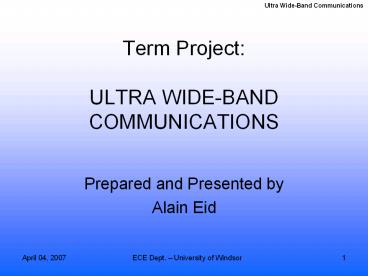Term Project: ULTRA WIDE-BAND COMMUNICATIONS - PowerPoint PPT Presentation
Title:
Term Project: ULTRA WIDE-BAND COMMUNICATIONS
Description:
... were built to bridge large distances in order to link two ... Four trends are driving short-range wireless in general and ultra-wideband in particular: ... – PowerPoint PPT presentation
Number of Views:223
Avg rating:3.0/5.0
Title: Term Project: ULTRA WIDE-BAND COMMUNICATIONS
1
Term ProjectULTRA WIDE-BAND COMMUNICATIONS
- Prepared and Presented by
- Alain Eid
2
Contents
- Introduction to UWB
- Definition of UWB
- IEEE 802.15.3a Standard
- Wireless Alternatives
- Multi-Bands Design
- UWB Transceivers
- Technology Challenges
- Conclusion
3
Chronology Research on UWB
- Is it a New Technology?
- The first impulse system patent was awarded in
1954 - The basic concept was first described in 1960
- The first landmark patent of UWB was awarded in
1973 - It has been used since 1980 in military Radar
applications - The term UWB was first used in 1989 by DoD
- Up to 1994, all UWB studies were classified
- A substantial change occurred in 2002 when UWB
was made public (by FCC) - The Answer is NO
4
Definition of UWB
UWB spectral mask for indoor communications
systems
5
Definition of UWB (Continued)
US Spectrum Allocation for Unlicensed Use
6
IEEE 802.15.3a Standard
IEEE 802.15.3a Summary Requirements
7
Wireless Alternatives
- In order to understand where UWB fits in with
the current trends in wireless communications, we
need to consider the general problem that
communications systems try to solve.
Specifically, if wireless were an ideal medium,
we could use it to send - a lot of data
- very far
- very fast
- for many users
- all at once
8
Wireless Alternatives (Continued)
- Unfortunately, it is impossible to achieve all
five attributes simultaneously for systems
supporting unique, private, two-way communication
streams. - One or more have to be given up if the others are
to do well. Original wireless systems were built
to bridge large distances in order to link two
parties together. - However, recent history of radio shows a clear
trend toward improving on the other four
attributes at the expense of distance.
9
Wireless Alternatives (Continued)
- Four trends are driving short-range wireless in
general and ultra-wideband in particular - The growing demand for wireless data capability
in portable devices at higher bandwidth but lower
in cost and power consumption than currently
available. - Crowding in the spectrum that is segmented and
licensed by regulatory authorities in traditional
ways. - The growth of high-speed wired access to the
Internet in enterprises, homes, and public
spaces. - Shrinking semiconductor cost and power
consumption for signal processing.
10
Wireless Alternatives (Continued)
Spatial Capacity Comparison Between IEEE 802.11,
Bluetooth and UWB
11
Wireless Alternatives (Continued)
Channel Capacity for Additive, White Gaussian
Noise
12
Multi-Bands Design
- UWB has been defined in the past as a method to
encode information using impulses. - These impulses can be modulated either with
position, or with amplitude or with phase. - The transmitter feeds these impulses to a very
large bandwidth, non-resonating antenna, or
sometimes the antenna itself shapes the impulses
to the required frequency of operation. - UWB companies have developed proprietary
techniques to generate and detect such impulses,
using non-resonating components. - These impulses are especially effective for radar
systems, where the resolution is proportional to
the bandwidth, but have proven difficult to
realize in CMOS so far.
13
Multi-Bands (Continued)
Multi-Band Signals Sequence
14
Multi-Bands (Continued)
Multi-Band Signal Reference
15
UWB Transceivers
Multi-Bands Transceiver Block Diagram
16
UWB Transceivers (Continued)
UWB Transceivers Typical Performance
17
UWB Applications
- Desktops and Laptop PCs
- High resolution printers, scanners, storage
devices - Connectivity to mobile and CE devices
- Mobile Devices
- Multimedia files, MP3, games, video
- Personal connectivity
- CE Devices
- Cameras, DVD, HDTV
- Personal connectivity
- Military Communications
- Radars and Sensing
18
Technology Challenges
- Short-range wireless systems based on narrowband
carrier modulation VS High data rates to transmit
video over air. - Spatial capacity VS System performance and
spectral efficiency of UWB radio devices.
19
Technology Challenges (Continued)
- Mutual interference between UWB devices VS Level
of QoS. - Modulation and channel coding VS Multi-User
capacity. - Peak power VS Optimization of transmission
techniques. - Excessive clock speed, synchronization, power
consumption VS MEMS and SOI
20
Conclusion
- The recently FCC frequency allocation for UWB has
generated a lot of interest in UWB technologies. - 7500MHz of spectrum for unlicensed use.
- Transmit signal must occupy at least 500MHz at
whole times. - UWB is the most promising technology to support
the rigorous requirements 110, 200 and 480Mbps. - The new UWB technology emerging today, mostly as
a consequence of the recent FCC spectrum
allocation, is based on multi-bands. - There are still many technologys challenges
ahead, mostly around the high level of
integration that UWB products requires they need
to be developed at low cost and low power to meet
the vision of integrated connectivity for PAN.































